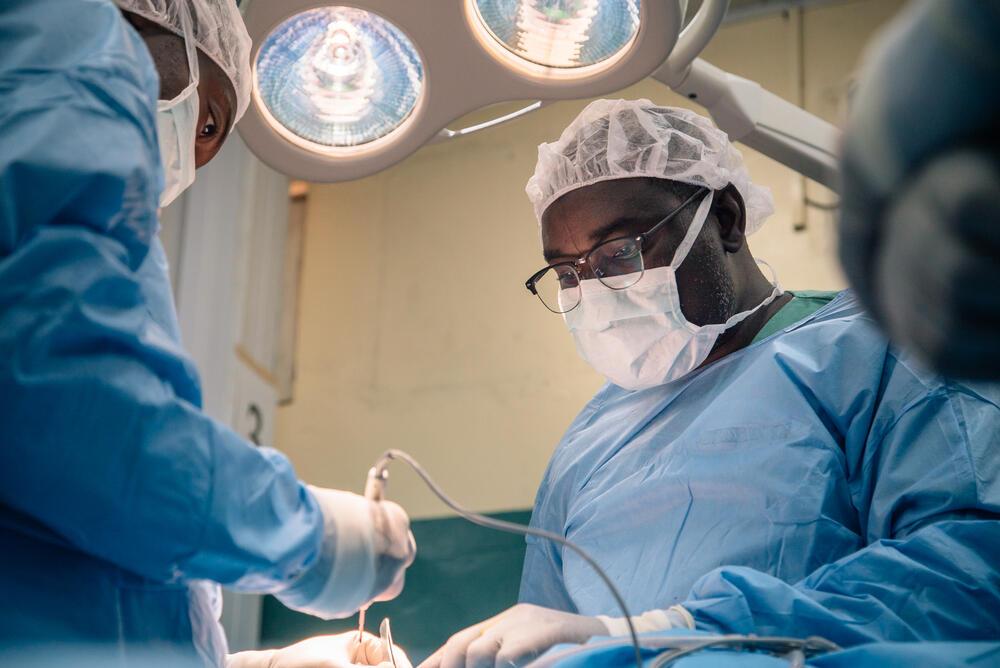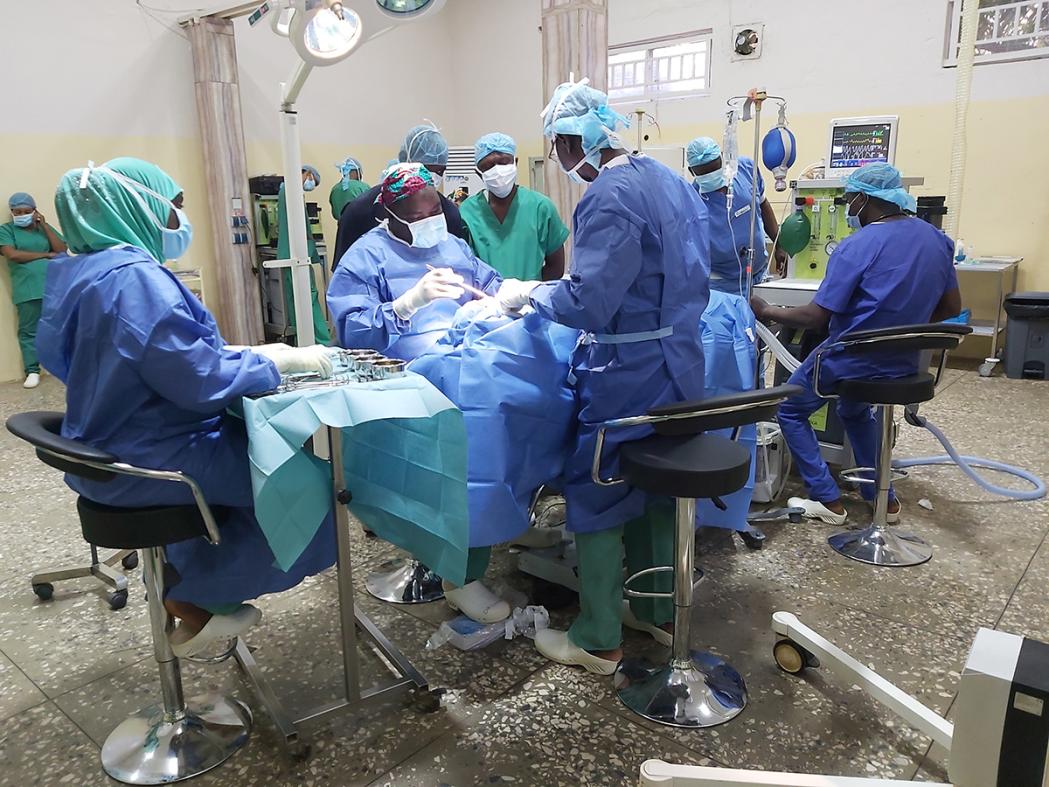Noma in Nigeria: Ado and Ifeoma's stories

Muhammad Lawal Abubakar (centre, with the pink and blue cap) performing life-changing noma surgery with the team at Sokoto © Charlotte Lee/MSF
Our plane circled the airport again, but it didn’t descend.
On board were four surgeons, one anaesthetist, and other members of Doctors Without Borders / Médecins Sans Frontières (MSF) staff. Below, beneath the thick Harmattan haze and dust, was the city of Sokoto, where over forty noma survivors, mostly children, were waiting for surgeries.
Eventually, the pilot made the announcement: the poor visibility meant there was no way to land. We would have to return to Abuja.
I am a consultant plastic surgeon from Zaria, Nigeria. In my regular job I work in a public hospital, mainly on reconstructive surgery after trauma or tumours. Whenever I can, however, I join surgical specialists from around the world and travel to Doctors Without Borders' noma project in Sokoto.
Noma
Noma is associated with poverty, because the disease mainly affects people who can’t afford nutritious food or good oral hygiene.
The infection starts in the gums and can spread to the face and jaw. It eats away at the tissue, causing facial disfigurements and potentially life-threatening impairments.
While the noma project offers medical care, counselling, and physiotherapy all year round, the surgeries are done in intensive two-week “interventions”, which happen three or four times a year.
It was another two days before the weather cleared and we were able to make the short flight from the capital. Usually, the first day of an intervention is a rest day, but we had lost too much time already.
We dropped our bags at the guest house and headed straight to the hospital. We had work to do.
Ado
One of the first noma survivors we saw was six-year-old Ado*. She had a large oral fistula – essentially a hole in the side of her face. Saliva leaked through constantly.
Ado was very quiet at our initial meeting. Her parents explained that talking made the leaking of saliva worse, and so the little girl had become very withdrawn.
No one wants to play with her. She speaks only in monosyllables. She no longer goes to school.
The team and I immediately started thinking about options. How could we best do the reconstruction so that Ado had a chance at a better life?
As a plastic surgeon, in any operation, you have a three-dimensional image in your mind that you want to recreate. No one else can see it, except your surgeon colleagues of course, who are part of the planning process.
Our work saves lives
Together, your work is to think as you go, moulding and shaping the face of that image. As we work, we make adjustments where necessary, amending the image we are working towards.
For Ado we opted for a simple procedure called a cervicofacial flap.
We took some of the soft skin from her neck and moved it up surgically, folding it on itself to create both the cheek and the lining of the mouth. The fistula was covered completely.
Everything went smoothly. Ado won’t be discharged until she’s had her post-operative screening, but already she’s looking much happier, playing with the other children.
Ifeoma
I’m hopeful that this will be the only surgery Ado needs. But for noma survivors who have multiple or wide defects, we have to do the surgery in stages. That’s what happened to Ifeoma*.
Completing all the surgical stages can take years, as some parts of the face, like the nose, can only be reconstructed once a person is fully grown.
That can be really hard on a young person who is facing significant stigma, so the Sokoto team gives counselling to help survivors understand that we’re not refusing them surgery, but that we need to wait to ensure a better outcome.

Muhammad Lawal Abubakar leading a surgical team at Doctors Without Borders' noma project. © Claire Jeantet - Fabrice Caterini/INEDIZ
Ifeoma is a young woman who was badly affected by noma. After several previous surgeries, she went through the final stages of a nasal reconstruction last year.
With such intricate surgery there can be complications, so when I saw her at Sokoto Hospital, what was running in my mind immediately were the potential surgical problems and how we might be able to help.
Dreams and aspirations
Noma survivors are just like anyone else. They have dreams. They have aspirations. As a surgical team we might not be able to completely disguise the fact that yes, this person has had a disease, and yes, they’ve had a reconstruction. Our goal with surgery is to allow noma survivors to move through life with as little functional impairment as possible, and facing less stigma, so that noma does not prevent them from achieving the things that they want.
When I think about Ifeoma’s new confidence, or Ado finally playing with the other kids, I feel like we’re achieving our goal.
This has been an intense trip. Because of the lost days, we had to condense our work, working longer hours and taking more cases each day. But the team spirit was high, we were all motivated by the noma survivors eagerly waiting for their surgeries. Now we’re exhausted but happy.
The next intervention will be in June. I hope to be back, alongside other members of the team. I am already looking forward to it.
*Names have been changed
This is a story shared by a Nigerian surgeon Muhammad Lawal Abubakar shares his experience, as well as the journey of two young noma survivors. It was published on the msf.org.uk website in 2022.
A consultant plastic surgeon from Zaria, Nigeria. In his regular job he works in a public hospital, mainly on reconstructive surgery after trauma or tumours. Whenever he can, he joins surgical specialists from around the world and travel to Doctors Without Borders noma project in Sokoto.